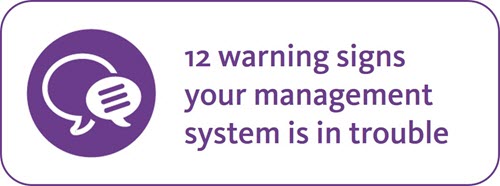And how to fix it if it has
Recently I got into a conversation with a Quality Manager who was disappointed he’d missed a webinar I’d just run about quality management (and ISO 9001:2015 in particular).
Jim (not his real name by the way) explained to me that he’d missed the webinar because of a production emergency.
The irony wasn’t lost on either of us - that he’d missed a webinar about quality management because of a quality issue.
Jim explained that his production emergency was a classic quality system breakdown which, alas, was happening on a regular basis. He said autocratic management practices were getting in the way of good quality. Decisions were being over-ruled by the Management Team because they “felt it was the right thing to do”. I said it sounded as though they didn’t really have a quality management system anymore – rather, it was a personality management system.

Warning signs your management system is in trouble
Unfortunately, what Jim is going through is very common. Here’s how it plays out…
Initially workers carry out their roles and follow the quality system diligently. Then, the next minute, Management - perhaps driven by one strong personality - makes changes to the quality system on a whim. They assume everyone is on the same page (despite having put nothing in writing). Then unforeseen circumstances arise. Normally a healthy system could cope with variation, but because Management changed things on impulse, the system breaks down. Production emergencies are the inevitable result. Lost product, lost time, lost money. Irritated customers. Damage to the organisation’s reputation and brand. And of course, the core integrity of the system is harmed.
In many organisations it’s obvious when the system is run along personality management lines. In others, there are just hints of personality management here and there. Over time these weaknesses result in the overall degeneration of the system but the realisation that this is happening can sneak up on you.
So how do you spot that your management system is going to the dogs? Here’s 12 warning signs that you need to look out for:
-
Changes are made on a whim.
-
The system exists primarily in a manager’s head. Little is written down.
-
Changes aren’t communicated to everyone.
-
The management style is based on assumption, rather than evidence.
-
Action taken is reactive, not proactive.
-
The system falls over if a key person leaves (or even takes an external holiday).
-
Management takes a short-term view when making decisions.
-
People do what’s easiest and/or quickest, not what’s best.
-
The Management Team rarely has contact with front-line workers.
-
Bad news is hidden.
-
When things go wrong Management blames individuals.
-
The underlying belief is that quality is the responsibility of one person only – the Quality Manager.
Poor old Jim
Let’s get back to Jim for a moment, who’s travelling all over the country dealing with these production emergencies. He’s constantly having to react to crises which of course, is taking him away from his core responsibilities as a Quality Manager. Instead of continually improving the system, he’s busy fighting fires. Over and over again.
Of course, the waste, lost time and lost customers will eventually show up on the bottom line, but not necessarily in an obvious way that will have Management directly accountable for the on-going fiascos.
If only there was a standard General Ledger accounting code for “Production Emergency Cost Due to Ad-hoc Management Style”!
Addressing the problem
Jim is clearly stuck between a rock and a hard place but he’s no quitter. So what should he do?
Certainly it’s not going to be easy, but there’s little choice. He’s going to have to go back to basics with his Management Team and Directors. He is going to have to educate them about what quality actually is.
He needs to help his Management Team see what’s really going on in their organisation and properly introduce them to the idea of quality costs. He will have to explain Val Feigenbaum’s notion of “a hidden factory within a factory”, whose (expensive) responsibility it is to clean up the messes. He is going to have to illustrate how quality is the responsibility of everyone in the organisation, whatever job they have.
He will have to convince, cajole - even demand – that his Board have a clear vision for quality.
Furthermore he’s going to have to keep on educating the staff for the foreseeable future. After all, it only takes one new manager ignorant of quality principles to send the whole organisation on a downward spiral towards a personality management system all over again. Jim knows the cost is too high to let that happen.
I firmly believe that there is measurable logic behind quality systems and that once people fully understand that, it takes a massive ego to dispute it. Don’t let the egos of those around you be allowed to ruin your systems - and your organisation. Be vigilant and proactive. Be like Jim.
.png?width=200&height=51&name=image%20(2).png)



